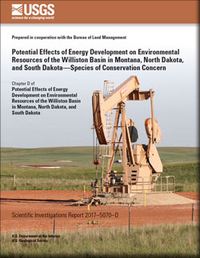Potential Effects of Energy Development on Environmental Resources of the Williston Basin in Montana, North Dakota, and South Dakota—Species of Conservation Concern
Links
- Document: Report (5.50 MB pdf)
- Larger Work: This publication is Chapter D of Potential effects of energy development on environmental resources of the Williston Basin in Montana, North Dakota, and South Dakota
- Tables:
- Download citation as: RIS | Dublin Core
Abstract
The ecosystems of the Williston Basin provide direct and indirect benefits to society. These benefits include carbon sequestration, flood control, nutrient rich soils for agricultural productivity, and habitat for wildlife. This chapter’s main focus is on the effects of energy development on species that occupy the ecosystems in the Williston Basin. We compiled a list of documented species of conservation concern that are of most interest to Federal regulators and resource managers. Species of concern were either listed as endangered or threatened under the Endangered Species Act or listed by States as species of concern in Natural Heritage Program checklists or State Wildlife Action Plans. All told, we determined that 357 species of concern likely occupy the Williston Basin. These species represented seven different taxonomic groups: plants (native and nonnative), terrestrial invertebrates, birds, mammals, reptiles and amphibians, and fish and mussels.
We reviewed the existing scientific information pertaining to potential effects of energy development on these taxonomic groups. Currently, little is known about the abundance and distribution of many of these species. But some information exists that may be useful in predicting the potential effects of energy development on certain taxonomic groups. Most of this information has been developed through scientific research focused on effects to mammal and bird populations. Effects to other taxonomic groups seems to be understudied. In general, it seems that disturbances and modifications associated with development have the potential to negatively affect a wide range of species; however, many studies produce uncertain results because they are not designed to compare populations before and after energy development takes place. Most of these studies also do not monitor resources over multiple years and thus cannot detect population trends. Likewise, there are few examples of landscape-scale assessments of the cumulative effects of energy development that could be used for species or habitat management purposes. We suggest that more research needs to be completed to measure potential effects to a broad range of species in multiple taxonomic groups. This may require also developing some understanding about the basic ecology of many of the species covered in this report. In concert with this more basic research, we also suggest that more comprehensive assessments of potential negative cumulative effects across the Williston Basin should be developed in an effort to guide more strategic management of biological resources.
Suggested Citation
Post van der Burg, M., Symstad, A.J., Igl, L.D., Mushet, D.M., Larson, D.L., Sargeant, G.A., Harper, D.D., Farag, A.M., Tangen, B.A., and Anteau, M.J., 2022, Potential effects of energy development on environmental resources of the Williston Basin in Montana, North Dakota, and South Dakota—Species of conservation concern: U.S. Geological Survey Scientific Investigations Report 2017–5070–D, 41 p., https://doi.org/10.3133/sir20175070D.
ISSN: 2328-0328 (online)
Study Area
Table of Contents
- Acknowledgments
- Abstract
- Overview
- Ecosystems of the Williston Basin
- Species of Conservation Concern in the Williston Basin
- Potential Effects of Energy Development on Species of Conservation Concern
- Summary
- References Cited
- Appendix D1
| Publication type | Report |
|---|---|
| Publication Subtype | USGS Numbered Series |
| Title | Potential effects of energy development on environmental resources of the Williston Basin in Montana, North Dakota, and South Dakota—Species of conservation concern |
| Series title | Scientific Investigations Report |
| Series number | 2017-5070 |
| Chapter | D |
| DOI | 10.3133/sir20175070D |
| Publication Date | September 13, 2022 |
| Year Published | 2022 |
| Language | English |
| Publisher | U.S. Geological Survey |
| Publisher location | Reston, VA |
| Contributing office(s) | Northern Prairie Wildlife Research Center |
| Description | Report: vii, 41 p.; 5 Tables |
| Larger Work Type | Report |
| Larger Work Subtype | USGS Numbered Series |
| Larger Work Title | Potential effects of energy development on environmental resources of the Williston Basin in Montana, North Dakota, and South Dakota (Scientific Investigations Report 2017–5070) |
| Country | United States |
| State | Montana, North Dakota, South Dakota |
| Other Geospatial | Bakken Formation, Williston Basin |
| Online Only (Y/N) | Y |
| Additional Online Files (Y/N) | Y |


